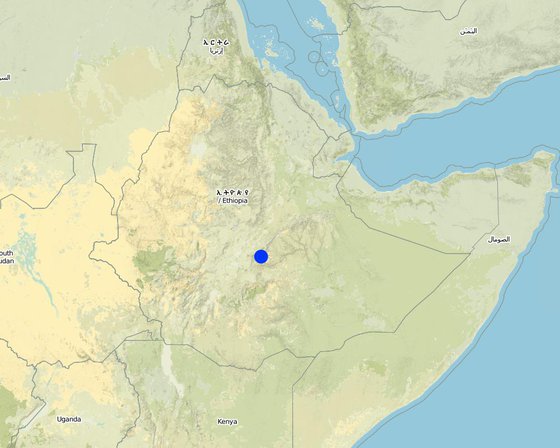

Stone-faced soil bund is constructed during the dry period when the field is free from crops (after crop harvest). Soils in the woreda are light and are easily eroded. A contour line is marked on the ground first and a foundation placing stones is dug. The stone wall is placed in the foundation and the wall is raised until it attains a height of 0.50m at minimum. Then earth is dug on the upslope side by removing soil from it and make an embankment of soil on the upper side to support the stone wall. In the same way the stone is supported by the soil from the upper side. The embanked soil is lightly compacted to avoid collapse. The objective is to control concentrated runoff from causing soil erosion and to retain as much rainwater as possible in the soil for mazimizing crop production. Livestock are not let on the terraced land. Most land users feed their animals tethered. The bund is then stablized by planting grass. The most commonly used grasses for stablizing bunds in the area are phalaris and elephant grass. The purpose is to control runoff and soil erosion from cultivated lands. Grass is planted to stablize the bund and also help in providing fodder for animals. Some land users stablize the stone-faced bunds by planting fruit trees. Fruit trees are often planted at the homesteads for better management and protection. The income obtaoned from fruit trees is high. Sorghum fields are predominantly treated by stone-faced bunds while chat and coffee fields are treated by ridges and basins. Frequent maintenance and upgrading is required until bench is formed. Currently most of the fields in the woreda have a properly stablized terraces and as a result loss of soil and water by erosion is decreasing. Maintenance is done continuously until the structure stablizes well and inparticular after heavy rains, every time after tillage and cropping. The technology is suitable in areas where stones are avialable and soils are light.

Location: Tullo, Oromia National Regional State, Ethiopia
No. of Technology sites analysed:
Spread of the Technology: evenly spread over an area (approx. 100-1,000 km2)
In a permanently protected area?:
Date of implementation: less than 10 years ago (recently)
Type of introduction




| Specify input | Unit | Quantity | Costs per Unit (n.a.) | Total costs per input (n.a.) | % of costs borne by land users |
| Labour | |||||
| Labour | ha | 1.0 | 125.0 | 125.0 | |
| Equipment | |||||
| Animal traction | ha | 1.0 | 46.6 | 46.6 | |
| Tools | ha | 1.0 | 5.5 | 5.5 | |
| Plant material | |||||
| Seeds | ha | 1.0 | 2.8 | 2.8 | |
| Seedlings | ha | 1.0 | 30.0 | 30.0 | |
| Fertilizers and biocides | |||||
| Fetilizer | ha | 1.0 | 33.3 | 33.3 | |
| Total costs for establishment of the Technology | 243.2 | ||||
| Total costs for establishment of the Technology in USD | 243.2 | ||||
| Specify input | Unit | Quantity | Costs per Unit (n.a.) | Total costs per input (n.a.) | % of costs borne by land users |
| Labour | |||||
| Labour | ha | 1.0 | 12.5 | 12.5 | |
| Equipment | |||||
| Tools | ha | 1.0 | 0.5 | 0.5 | |
| Plant material | |||||
| Seedlings | ha | 1.0 | 3.0 | 3.0 | |
| Fertilizers and biocides | |||||
| Fertilizer | ha | 1.0 | 33.3 | 33.3 | |
| Total costs for maintenance of the Technology | 49.3 | ||||
| Total costs for maintenance of the Technology in USD | 49.3 | ||||
due to increase in soil misture and erosion control due to measures
planataion on the hillsides and on bunds
planataion on the hillsides and on bunds
area closures and hillside planataions
crop production increased
farmers get organized in groups for conservation activities
land users appreciating conservation interventions increasing
Quantity before SLM: 50
Quantity after SLM: 0
ruinoff trapped
Quantity before SLM: 60
Quantity after SLM: 4
because of measures